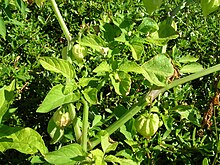Physalis angulata
| Physalis angulata | |
|---|---|

| |
| Cutleaf groundcherry | |
| Scientific classification | |
| Kingdom: | Plantae |
| Clade: | Tracheophytes |
| Clade: | Angiosperms |
| Clade: | Eudicots |
| Clade: | Asterids |
| Order: | Solanales |
| Family: | Solanaceae |
| Genus: | Physalis |
| Species: | P. angulata
|
| Binomial name | |
| Physalis angulata | |
| Synonyms[1] | |
|
List
| |
Physalis angulata is an erect herbaceous annual plant belonging to the nightshade family Solanaceae. Its leaves are dark green and roughly oval, often with tooth shapes around the edge. The flowers are five-sided and pale yellow; the yellow-orange fruits are borne inside a balloon-like calyx. The exact native range is uncertain.[2][3][4] The species may be naturally endemic to Australia[5] or the Americas[6] or the native range may encompass both the Americas and Australia.[7][5] It is now widely distributed and naturalized in tropical and subtropical regions worldwide.
The plant produces edible fruit that can be eaten raw, cooked, jammed, etc. However, all other parts of the plant are poisonous.[8] Members of the Toba-Pilagá ethnic group of Gran Chaco traditionally eat the ripe fruits raw.[9] Unripe raw fruits, flowers, leaves, and stems of the plant contain solanine and solanidine alkaloids that may cause poisoning if ingested by humans, cattle or horses.[10][11]
Vernacular names
[edit]- English common names include: angular winter cherry,[12] balloon cherry,[12] cutleaf groundcherry,[12][13] gooseberry,[12] hogweed,[12] wild tomato, camapu, and occasionally other common names for the genus Physalis.
- In Spanish it is known as bolsa mullaca[14]
- In Malayalam it is known as njottanjodiyan and mottaampuli.
- In Indonesian it is known as ceplukan or ciplukan.
- In Sundanese, it is known as cecendet
- In Suriname it is known as batoto wiwiri.
- In Meru it is known as Nkabakabu.
- In Egyptian Arabic it is known as Hrankash.
- In Yoruba it is known as Koropo
- In Guarani it is known as Kamambu
References
[edit]- ^ "Physalis angulata L." Plants of the World Online. Royal Botanic Gardens, Kew. Retrieved 10 February 2023.
- ^ "Factsheet - Physalis angulata (Wild Gooseberry)". keys.lucidcentral.org. Retrieved 31 January 2024.
- ^ Travlos, Ilias (7 January 2022). Physalis angulata (cutleaf groundcherry) (Report). doi:10.1079/cabicompendium.40711.
- ^ "Physalis angulata". keyserver.lucidcentral.org. Retrieved 31 January 2024.
- ^ a b "Factsheet - Physalis". www.flora.sa.gov.au. Retrieved 31 January 2024.
- ^ "Physalis angulata L. | Plants of the World Online | Kew Science". Plants of the World Online. Retrieved 31 January 2024.
- ^ "NT Flora". eflora.nt.gov.au. Retrieved 31 January 2024.
- ^ "Physalis angulata (cut-leaved ground-cherry): Go Botany". gobotany.nativeplanttrust.org. Retrieved 13 June 2021.
- ^ Arenas, Pastor; Kamienkowski, Nicolás Martín (December 2013). "Ethnobotany of the Genus Physalis L. (Solanaceae) in the South American Gran Chaco". Candollea. 68 (2): 251–266. doi:10.15553/c2012v682a9. hdl:11336/8358. ISSN 0373-2967.
- ^ "Physalis". North Carolina State University, Extension Gardener. 2023. Retrieved 23 February 2023.
- ^ "Ground cherry, Chinese lantern". Guide to Poisonous Plants, Colorado State University. 2022. Retrieved 23 February 2023.
- ^ a b c d e "Physalis angulata". Germplasm Resources Information Network. Agricultural Research Service, United States Department of Agriculture. Retrieved 14 July 2014.
- ^ Physalis angulata (USDA)
- ^ Rengifo-Salgado, E; Vargas-Arana, G (2013). "Physalis angulata L.(Bolsa Mullaca): a review of its traditional uses, chemistry and pharmacology". Boletín Latinoamericano y del Caribe de Plantas Medicinales y Aromáticas. 12 (5): 431–445.
External links
[edit]- "Physalis angulata L." Atlas of Living Australia.
